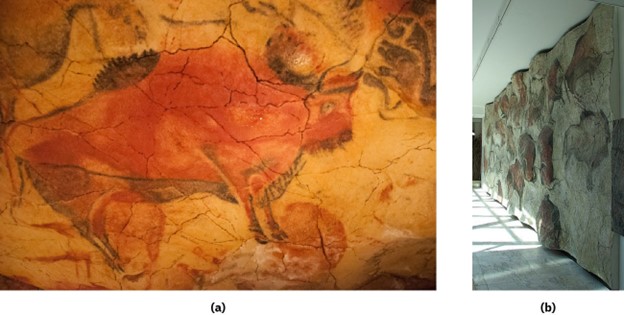2 Life in the Paleolithic Age
Human populations remained small, relying on subsistence hunting and gathering for survival, until around 12,000 years ago. Typical groups consisted of 15-40 people, subdivided into family units. Their small size fostered close relationships and cooperation, essential for survival. Diets varied depending on the environment, consisting of nuts, fruits, berries, wild grains, fish, birds, shellfish, insects, and animals. Hunting strategies included spears, nets, and hooks made of bone. Large-game hunts, like those of deer, horses, and woolly mammoths, required cooperation and sophisticated tools. Shelter options included built structures and natural refuges like caves, with some populations occupying the same cave for tens of thousands of years. When needed, humans designed their own shelters using local materials.
Evidence suggests that modern humans developed some form of spirituality or religion, possibly animism, to make sense of the world. Cave paintings and burial sites, sometimes including household items and ornate decorations, may be traces of their beliefs. While it’s difficult to know the exact nature of their spirituality, it’s clear that they had some form of religious tradition. Paleolithic societies were likely egalitarian, due to their small size, lack of wealth, and nomadic lifestyle. However, some differentiation within groups existed, recognizing varying physical abilities, intelligence, charisma, and other traits.
To understand how early humans lived, archaeologists study the objects left behind, primarily made of stone, as they are the most durable. The use of stone tools marks the beginning of the Paleolithic Age, around 3.3 million years ago, and lasted until 12,000 years ago. The earliest known human-made stone tools, Oldowan tools, date back to 2.6 million years ago, likely created by Homo habilis. These crude tools were made by smashing rocks together to create sharpened edges, used for cutting, scraping, and chopping tasks. Around 1.7 million years ago, a new style of stone tool emerged, the Acheulean tool, characterized by a teardrop shape and sharper edges. These hand-axes were more efficient and sophisticated, used for tasks like butchering meat and smashing bones. They were a significant improvement over Oldowan tools and have been found in Africa, the Middle East, India, and East Asia. These early stone tools represent a significant leap in human engineering ability, showcasing the resourcefulness and adaptability of early humans.
Fire was a crucial tool for early humans, providing warmth, protection, and a means to cook food. While the exact timeline of fire control is debated, evidence suggests modern humans mastered it by at least 125,000 years ago. Fire had various practical applications, including cooking, warmth, and tool manufacturing. Additionally, it played a significant social function, aiding in bonding and group survival, and likely facilitated the development of language.
Language was another vital tool, enabling early humans to communicate complex ideas, coordinate tasks, and pass information to future generations. This ability to convey abstract thoughts and collaborate with others gave modern humans a significant advantage over competing animals.
Artistic expression also emerged, with early humans creating small sculptures of animals and humans, often symbolizing fertility. Hand prints, made by placing a hand on stone and blowing pigment around it, were also preserved. The most stunning examples of prehistoric art are the cave paintings, dating back to 40,000 years ago, which showcase detailed animal depictions. The Cave of Altamira in Spain features impressive examples of such art, with 25 large animal images created using charcoal and ochre. These artistic expressions demonstrate the cognitive and creative abilities of early humans, highlighting their capacity for complex thought and communication.

(b) Other examples of three-dimensionality in the art of Altamira are apparent in a Czech museum’s model of the cave’s ceiling. Source: OpenStax
Throughout much of human history, our ancestors lived in an ice age, where colder temperatures and scarce resources made survival a daily challenge. In this harsh environment, early humans relied on each other and their communities to access basic necessities like food, water, and shelter. Small, tight-knit groups formed, often migrating to ensure their survival. In areas with more abundant resources, settlements became more permanent, allowing for artistic and social pursuits to flourish.
Survival was difficult, and cooperation was vital. This led to the development of egalitarian societies, where resources were shared and everyone contributed to the group’s well-being. While men and women had different responsibilities, such as hunting and gathering, they worked together to ensure the group’s survival. The resilience and innovation of early humans allowed them to thrive in challenging environments, relying on their natural surroundings for resources and adapting to changes and challenges as they arose.
Link to Learning
We know that our Paleolithic ancestors communicated with each other through language and that this exchange was vital for cooperation. But did they also have a type of written communication? Some researchers think it’s possible that seemingly abstract signs preserved in caves represent just that. Watch this short video about fascinating scholarship around these intriguing cave signs (https://openstax.org/l/77CaveSigns) to learn more.
